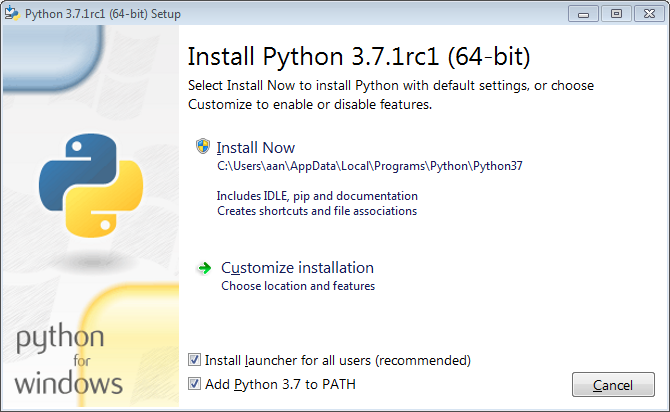


Press ‘OK’ and you would then see your new Python Path under the ‘User variables’ section.

Put all the values together in the New User Variable box: This is how my Variable value looks like:Ĭ:\Users\Ron\AppData\Local\Programs\Python\Python37-32 C:\Users\Ron\AppData\Local\Programs\Python\Python37-32\Scripts Now let’s fill the New User Variable box that you saw earlier:įor the Variable value, copy the full Python application path, then use semicolon (as highlighted in yellow below), and finally copy the Python Scripts path. Here is how my Python application path looks like:Īnd this is how my Python Scripts path looks like: The Scripts folder should be located within the Python application path.

The Python application path, which is the folder where you originally installed Python and You should then see the following box, which will allow you to add/edit variables:īefore you type any values, you’ll need to locate the relevant Python paths. That should take you to the Environment Variables screen, where you can add/edit your paths.Ĭlick on ‘New…‘ to add the ‘Path’ variable (note that if your ‘Path’ variable already exists, then click on ‘Edit…’ instead): Next, click on the ‘Advanced system settings‘įinally, click on the ‘Environment Variables…‘ To navigate to the Windows Environment Variables screen, where you can add/edit your paths, simply right click on the ‘This PC‘ icon. Step 1: Navigate to the Windows Environment Variables screen Note that I’ll be using Windows 10 to demonstrate the steps, but similar principles would apply for previous versions of Windows. If you wish to stick with your previous version of Python, you may apply the steps below to manually add Python to Windows path. Method 2: Manually add Python to Windows Path In the Python installation box, just check the box to add Python to PATH as below:įinish the installation, and you should be good to go.Īlternatively, you may manually add the paths into the Environment variables. In my case, the latest version of Python that was available to download was version 3.7.2. You can easily add Python to Windows path by downloading a recent version of Python, and then checking the box to Add Python to PATH during the installation.īefore you proceed, you may choose to uninstall your previous version of Python if needed. Method 1: Install a Recent Version of Python To overcome this error, you may apply any of the two methods described below. ‘pip’ is not recognized as an internal or external command, operable program or batch file Well, if you try to install a Python package using PIP for example, you may get the following error in the Windows Command Prompt: Via the installation of a recent version of Pythonīut why would you want to add Python to Windows path in the first place? In this guide, I’ll share with you two methods that you can use to add Python to Windows path: There are few ways in which you can add Python to Windows PATH.


 0 kommentar(er)
0 kommentar(er)
